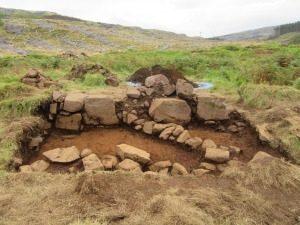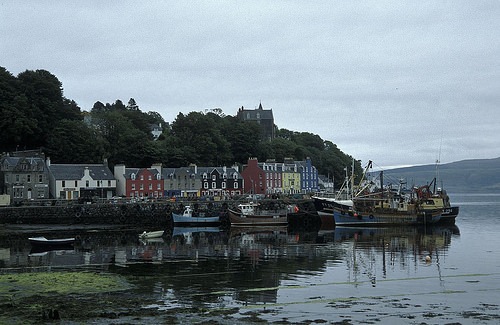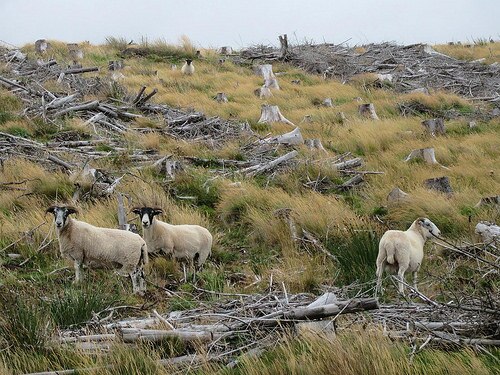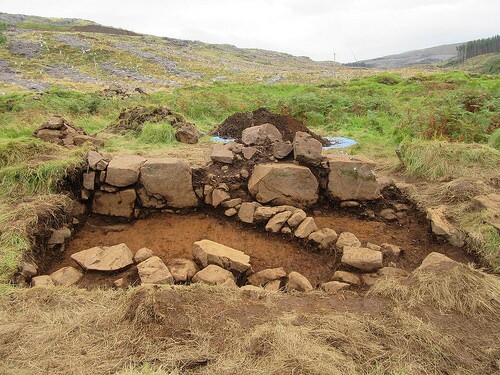
In the summer of 2016, a small team of archaeologists and field school students could be seen carefully working the earth at the base of a steep slope on an island off the west coast of Scotland. The island, known as Mull, is one among 79 other islands in the Inner Hebrides, an archipelago just off Scotland’s picturesque west coast.
Life on Mull is simple, steeped in commercial traditions of fishing, crofting, and whisky distilling. But it also draws tourists for its picturesque seaside beauty, the colorful houses of Tobermory village, and the Tobermory distillery — including other visual remnants of a past that goes back hundreds, even thousands, of years.
______________________________________
A view of Tobermory. Torsten Henning, Wikimedia Commons
_______________________________________
The archaeological team, under the auspices of the Heritage and Archaeological Research Practice (HARP) in collaboration with the Mull Archaeology Interest Group (MAIG), is investigating the remains of a small historic settlement known as Kildavie in the North West Mull Community Woodland of Langamull. No one has lived in this place for hundreds of years, but it was occupied in the 17th and 18th centuries. The remains of sixteen buildings have been identified thus far. The archaeologists suggest they were primarily domestic dwellings, with perhaps some evidence of a cottage industry.
“There is archaeological and historic evidence that Kildavie was a domestic settlement in the 17th and 18th centuries until it was abandoned at the beginning of the 19th century,” says Kate Leonard, an archaeologist who was working at the site during the summer of 2016. “The reason for its final abandonment is unknown, as is the origin of the settlement.”
But digging and research at the site could provide some clues for answers. Who were these people and why did they leave?
There is no written history of this settlement. But some historical context could help frame the inquiry.
“While there is a grand narrative about the Highland Clearances in this part of the country – with some very real and harrowing accounts to go along with it – the story is not straightforward in every case,” continues Leonard. “While some people were quickly forced out of their homes, other places were more gradually abandoned and Kildavie may be one of these.”
The Highland Clearances saw the forced eviction or displacement in the 18th and 19th centuries by aristocratic landowners of a large number of people or crofters, people who made their living as tenant farmers of small parcels of land. The landowners required the land to be converted to use as grazing area for the new agricultural revolution — sheep raising and herding. Many of the evictions were brutal, and the actions had the effect of depopulating the Hebrides and displacing them to other areas of Scotland and even other countries and continents, such as the Americas and Australasia. It profoundly impacted the indigenous Gaelic culture.
Was the fate of Kildavie the result of the Clearances?
The archaeology at the site has yet to answer this question. In the meantime, however, digging and analysis can provide clues to how these people lived and what their settlement may have looked like in the 17th and 18th centuries.
“By excavating as wide a variety of structures as possible the team hopes to identify differences in dates of occupation and use of the structures,” says Leonard.
“The team is also investigating the possibility that one or two of the structures were built for something other than a domestic dwelling; for instance, for a cottage industry. It also seems that some buildings were ‘renovated’ and re-used for another purpose. This type of later reuse can be seen in the small dividing walls built in some of the structures, possibly after they went out of use as a home.”
_______________________________________
Sheep: A common site in the excavation area. Photo courtesy Kate Leonard
___________________________________________________
The archaeological team at work on site. Photo courtesy Kate Leonard
___________________________________________________
Revealing unwritten history through archaeology: Investigation of the structures and the associated artifacts will help shed light on the functions of the structures and the lives of the people who once occupied them. Photo courtesy Kate Leonard
____________________________________________________
Leonard’s group excavated two small trenches. They were exploring the construction of walls and the entrance of a dry-stone built structure. “By the end of the dig we had exposed the floor layer in one trench and had revealed the structure of the wall in the other.”
Work at the site has been an ongoing endeavor, and the team has set its sights ahead.
Concludes Leonard, “there is more work to be done and the trenches will be reopened next season so the questions we have will still be investigated.”
To learn more about the dig at Kildavie (and the other excavations HARP organizes), see their website. http://www.harparchaeology.co.uk/
_______________________________________
Leonard’s time at the excavation was for but a brief period. She moves on to Hawaii, where she will be participating in another project as part of a global year-long journey to work at twelve different archaeological sites in 12 separate countries. She calls her project Global Archaeology: A Year of Digs. Kildavie was the 9th stop on her global trek.
Popular Archaeology will be following and reporting on Leonard’s worldwide experiences periodically throughout 2016 as she hops from one location to another during her global journey. To continue the work, however, Leonard will need financial support from donors. Readers interested in reading about and supporting her self-directed Global Archaeology crowdfunded project can learn more at gofundme.com/globalarchaeology.
You can read more about Leonard’s experience at Kildavie here.
_______________________________________

______________________________________________
Travel and learn with Far Horizons.
____________________________________________
This richly illustrated issue includes the following stories: Recent findings shedding new light on the whereabouts of the remains of Philip of Macedon, father of Alexander the Great; how an archaeologist-sculptor is bringing bones of the dead back to life; archaeologists uncovering town life at the dawn of civilization; an exclusive interview with internationally acclaimed archaeologist James M. Adovasio about what makes the Meadowcroft Rockshelter prominent in the ongoing search for the first Americans; what archaeologists are finding at the site of the ancient city of Gath, the home town of the biblical Philistine giant, Goliath; and how scientists are redrawing the picture of human evolution in Europe. Find it on Amazon.com.










